Why did so many men from northeast Scotland play such an important part in the development of Russia’s army and navy? According to the American writer, Washington Irving, it was down to the topography of their homeland – the flat coast, eastward-facing that produced
men of the clearest brains, the strongest arms, and the most determined wills, to a country in which these commodities have never been wanting.
Russia’s military and naval might might not be what it is today had it not been for a few Scotsmen. Quite a few Scotsmen as it turns out but one or two who were instrumental in reorganising the Russian empire’s defences (and lines of attack.)
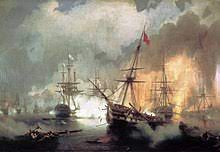
Since boats were boats Scots sailed to the Baltic from Aberdeen and Leith and points in-between to trade, to study and ply their crafts – including the arts of war. Mackenzies, Lindsays, Watsons, Farquhars, Hays, Elphinstones, MacLeods, Learmonths – George Mikhail Lermontov, ensign in the Russian army and descendant of Thomas the Rhymer, Gordons.
There are a lot of Gordons in Scotland and quite a lot were to be found in Russia over the past four hundred years.
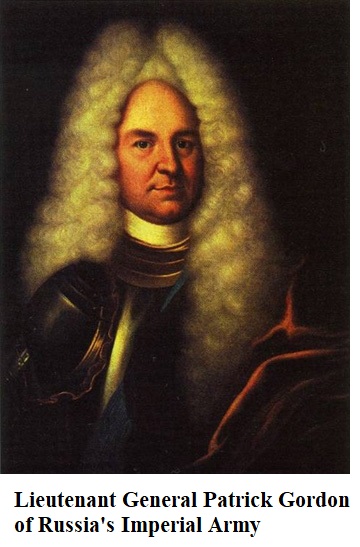
Patrick Gordon from Auchleuchries in Aberdeenshire was in danger as a Catholic from the religious civil wars that brought Cromwell to power so at the age of sixteen he was taken by his father and uncle to Aberdeen to purchase clothes and put him aboard a merchant ship sailing to Danzig. Danzig (now Gdańsk) then held within a union between Poland and Lithuania was an important Baltic port. There he found accommodation with another Scot, John Donaldson, before making his way across Europe, lodging as he went mainly with Scots with whom he was put in contact. For a time he travelled with fellow-countrymen, Thomas and Michael Menzies and a Jesuit priest, Father Blackhall.
Not familiar with the local languages and dialects young Gordon struggled at first to get by speaking Latin and a smattering of Dutch. One particular day it all got too much for Gordon and he sat down on the roadside and wept from desperation but on being comforted by a stranger the young lad found the determination to continue.
In 1655 young Patrick Gordon, a capable swordsman, did what thousands of his compatriots did, he sold his battle skills to the highest bidder, as a mercenary soldier. He enlisted with the Swedish army as a cavalryman. Opportunities there were plenty for mercenaries with Europe in constant turmoil battling over land and power. Gordon’s allegiances switched about. He fought with the Swedes at times and at other times with the Poles, against his former comrades. It was while in the pay of the Swedes he found himself a prisoner of a Russian force led by Scot, Colonel John Crawford (Crawfurd). Crawford persuaded Gordon to cross to the Russian Imperial army where he was told he’d be in the company of many Scotsmen.
Patrick Gordon proved himself again and again on the battlefield and he rose through the ranks becoming a Major General, later Lieutenant General and Chief of Command at Kiev (Kyiv in Ukraine). By this time Gordon had become Pyotr Ivanovich, a trusted adviser and friend to the Tsar, Peter the Great. Gordon was the first foreigner in Russian history that a Tsar visited privately, when eighteen-year old Peter went to Gordon’s house in Moscow’s German Quarter. Trusted implicitly by him, Gordon laid the foundations of Peter the Great’s army that became the strongest in Europe.
Gordon died in 1699 at the age of sixty-four having served under three Tsars. The young Scottish laddie broken by loneliness fifty years earlier ended his life deeply mourned by a Tsar who provided his friend with a state funeral.
By the Grace of God, We Peter the First, Tsar and Sole Monarch of all Russi …blah blah blah …Be it known to Every one, That We have Graciously Appointed and Constituted Thomas Gordon (Captain Commander in our Navy for his well recommended to us Experiences, Dilligence and Zeal for our Service) to be our Rear Admiral the first day of January, 1719… blah blah etc etc.
*
Gordon’s namesake who made a career for himself with the Swedish and Polish armies in which he attained the rank of Lieutenant Colonel and earned the nickname, Steel Hand for his swordsmanship, is sometimes confused with the Auchleuchries Gordon.
*
Another Gordon was Thomas Gordon, sometime captain of a merchant ship, Margaret, that sailed out of the port of Aberdeen, and was in 1703 in charge of the Royal Scots Navy ship, Royal Mary. Until the Union in 1707 Scotland was often the target of English aggression and ambition – some incidents were deadly and others petty though revealing such as Scottish vessels being denied the right to fly the Scottish pennant when in English waters. Following Union with England the Scottish Navy was scrapped in favour of the continuation of England’s Royal Navy. Scottish vessels and crews were absorbed into it and where both navies included identically-named vessels Scottish ships were ordered to change names – a move that was unpopular with Scots crewmen. From the start of the Union it was clear Scotland would be an inferior partner.
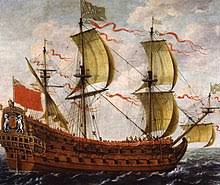
Thomas Gordon tholed so much English high-handedness but he refused to take an oath to the newly-crowned George I and left the navy, sailing to France where he stayed for a time before joining the Russian navy in 1717. He was promoted to Admiral in 1727 and later made Chief Commander of the Russian maritime port of Kronstadt.
In common with numerous other Scots of the sixteenth, seventeenth and eighteenth centuries Thomas Gordon’s family settled in Russia, either marrying Russians or bringing up their families as Russian. Ann Young was Thomas Gordon’s granddaughter. She married Thomas Mackenzie (Mekenzi) a Rear-Admiral in the Russian Navy. Their son, Thomas, also became a Rear-Admiral in the Imperial navy and founder of the city of Sevastopol – the largest city in Crimea and principal port on the Black Sea, in 1783. Sevastopol under him became a vital station for naval supplies as well as developing its shipbuilding capacity. The Mekenzi mountains in Ukraine are named in honour of him.
*
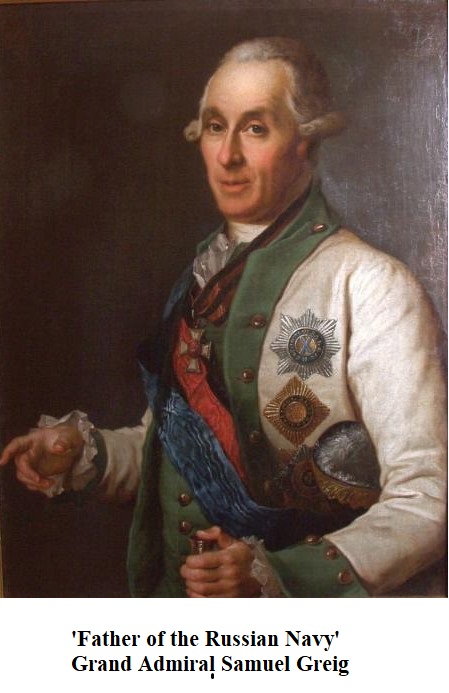
The ’Father of the Russian Navy’
The Sevastopol Thomas Gordon served under another Scot, Samuel Greig. Greig, the son of a merchant captain from Inverkeithing in Fife, became an Admiral and then Grand Admiral during the period of Tsarina Catherine the Great, who tasked him with modernising the Imperial Navy. She was the godmother of Samuel Greig’s son, Aleksei Samuilovich Greig, who was given the rank of midshipman at his birth. Almost inevitably the younger Greig made the navy his life. In 1816 he was appointed Commander in Chief of the Black Sea Fleet and ports at a time when Russia had full control of the Black Sea. Other Greigs enjoyed status roles in both the Russian army and navy. This family were part of the elite of Russian society for a century and a half but the sons were educated in Edinburgh.
When the ‘Father of the Russian Navy’, Samuel Carlovich Greig, died he was given a magnificent funeral. Laid out with full pomp Greig was dressed in his Admiral uniform, his many medals illustrating his service to Russia Governor of Kronstadt, Chevalier of the Order of St Andrew, St Alexander Newski, St George, St Vladimir, St Anne. A crown of laurel was placed on his head. At the foot of the black-draped bier in a silver urn were his bowels.
If Great and Good Actions Command the Respect of Mankind, The name of Greig will live for Ever. He deserved good Fortune, And he found it under the Banners of Cath.II. He scattered the Enemies of Russia . . . *
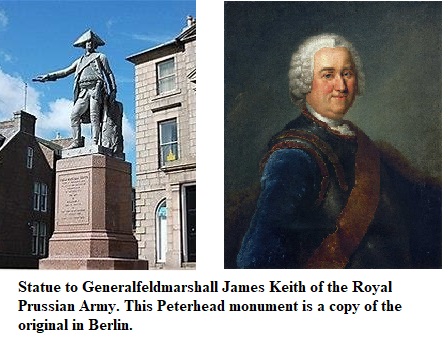
James Keith from Inverugie in Aberdeenshire who became a General Field Marshall in the Prussian army, a major military leader in Europe and trusted friend and adviser to Frederick the Great was for a time responsible for the Russian forces in Finland then being fought over by Russia and Sweden. Keith was one of three Inspector Generals of the Russian forces – his responsibility being the frontier with Asia along the rivers Volga and Don and a section of the border with Poland. Keith, however, did not settle in Russia but transferred into the service of the Prussia’s Frederick the Great. Like so many fellow-Scots, Keith was forced to flee Scotland because of his religion and/or his support for the Jacobite cause. He did briefly return to Aberdeenshire once no longer branded an outlaw but couldn’t settle having lived so long on the Continent. He returned to the army and died, killed by cannon fire at the Battle of Hochkirch in 1758. He had been let down by the man whose ear he normally had, Frederick the Great. Keith had warned him his Prussian troops were in grave danger from the Austrians if they didn’t alter position. Frederick disagreed, and Keith paid the ultimate penalty, knocked out of his saddle, he was killed instantly. Generalfedlmarschall Jacob von Keith has a granite memorial at Hochkirch.
*
An earlier army reformer with Russia’s Imperial forces was Alexander Leslie of Auchintoul in Banffshire (now Aberdeenshire). Alexander Leslie fought for the Swedes and Poles before transferring to the Russians and becoming Russia’s first General. Leslie recruited men from Scotland as part of his army improvements. He returned to the British Isles and took up arms in the Civil Wars for the Duke of Montrose and was ultimately banished from Scotland. Returning to Russia he lived out his life there, dying in Smolensk in 1663. His son, John, was killed while a Colonel in the Russian cavalry. John was married into the Scot-Russo Crawfords mentioned above.
*
Thomas Dalyell (Dalziel) of Binns, West Lothian, Bluidy Tam, fought in the Scottish Royalist army. In the civil wars a price of 200 guineas was put on his head. Not unsurprisingly he fled to Russia, into the service of Tsar Alexis I where his brutal reputation earned him the nickname, Muscovite De’il. He did not remain in Russia but returned to Scotland to crack down on the Covenanters with such force he came to be known here as Bluidy Tam.
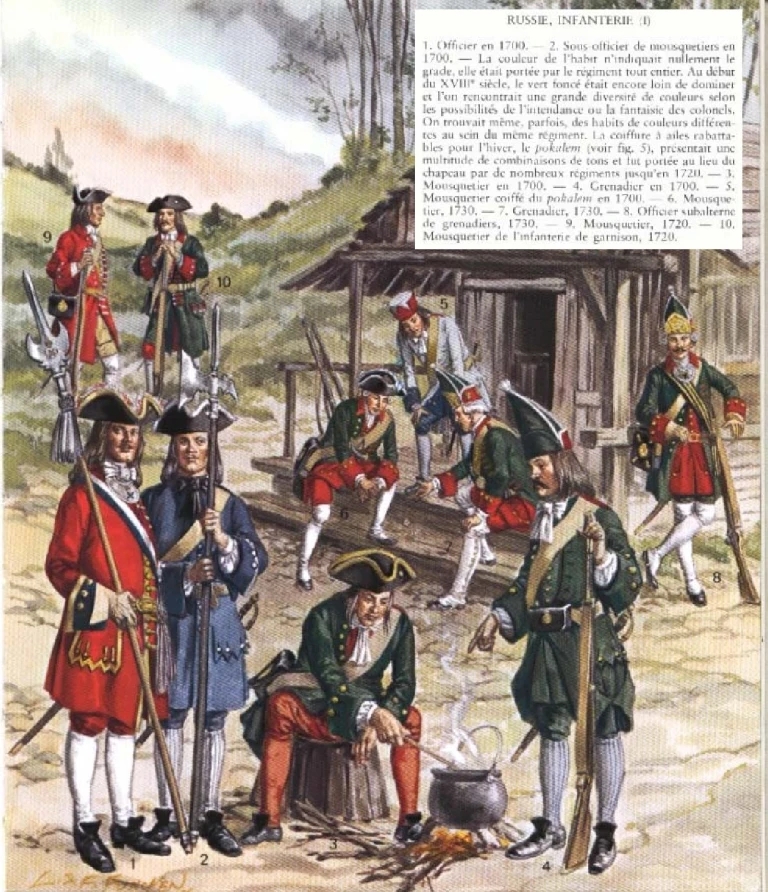
Robert Bruce, not that one but a later scion of the clan, whose family under James Daniel Bruce settled in Russia in the mid-1600s – Robert, Roman Vilimovich Bryusov, served in Peter I’s personal guard and he became the first Commander of St Petersburg. His army career lasted around thirty years and when he died in 1720 he was buried in the Peter and Paul Fortress in St Petersburg,
Other members of the Bruce family were prominent in Russian society. Robert’s son, Alexander Romanovich Bruce was a Lieutenant-General in Russia’s Imperial army. Alexander’s uncle, Jacob Bruce, was primarily a diplomat and scientist (astronomer and naturalist – and also an alchemist and magician) but he also did a stint in the Russian army during the Russo-Turkish war and the Great Northern War when he was promoted to Major-General of Artillery – and rewarded for his successes by being made a count, one of the first in Russia, almost exactly 300 years ago. Other Scots would follow into the Russian nobility.
When they travelled Scots took with them their birth brieve – a birth certificate with details of their origins. Additional documentation was kept in the Propinquity Registers of Scotland. Aberdeen holds some of these among its unique collection of archives dating back to Robert the Bruce’s time. Propinquity Books provided early modern travel documents. There’s an entry on 9th July 1725 relating to the family of the late James Gordon of Auchleuchries, ‘brigadier in the service of the Emperor of Russia’ that records the disposal of his property to his kin in Scotland.
Aberdeen’s Propinquity Registers reveal the importance and extent of Scotland’s east coast maritime trade with Europe. Sailing from Scottish ports such as Aberdeen to Baltic ports “the path to the Baltic ports was easier, and the welcome greater, than the highway that led to England” it has been said. Europe provided opportunities for wealth and reputation and many a Scottish family counted their fortunes in Russian rubles.